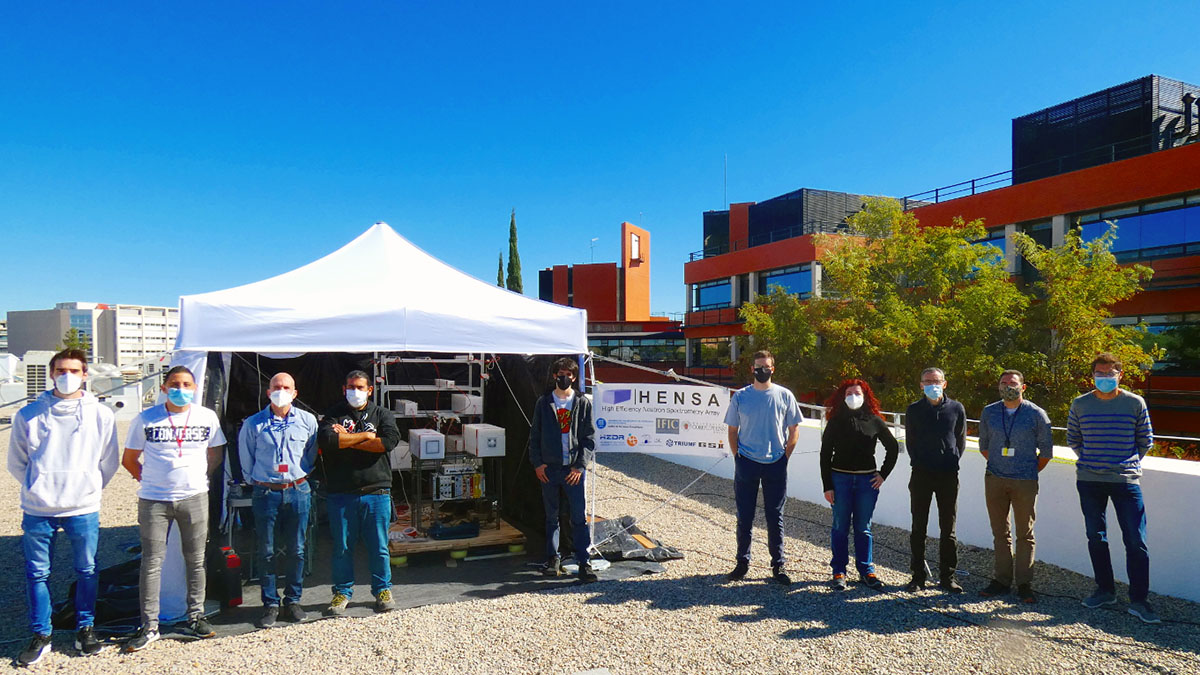Hensa's team
Researchers from the Institute of Corpuscular Physics (IFIC, UV-CSIC) participate in the HENSA project, aimed at measuring the flux of neutrons from cosmic rays in different areas of Spain. This flow of particles is associated with failures in microcomputer systems that can affect telecommunications or navigation. The study also provides data on the interaction between solar activity and the atmosphere.
The neutron flux from cosmic rays is also responsible for much of the radiation received during commercial flights and can provide information about the so-called ‘space weather’, that is, the interaction between solar activity and the atmosphere.
The HENSA (High Efficiency Neutron Spectrometry Array) project seeks to characterise the neutron background produced by cosmic rays during the minimum activity of the Sun. And it does so by using a high-efficiency neutron spectrometer, designed to determine said environmental neutron background both in laboratories. low radioactivity underground and on the earth’s surface.
The minimum solar activity is associated with the Sun’s magnetic cycle, which has a period of eleven years, and which took place in 2020 between the months of February and November, the optimal time to measure the neutron spectrum at different locations and altitudes at throughout the Spanish territory.
Huesca, Cantabria, Granada, Valencia, Teruel, Madrid and Barcelona are home to the institutions that have been part of the first measurement campaign that HENSA carried out in Spain. After taking measurements at the Astún ski resort and at the Canfranc Underground Laboratory (LSC) headquarters – both in Huesca –, as well as at the Cantabria Physics Institute (IFCA), HENSA collected data from the Sierra Nevada Observatory (OSN), at 2,896 meters high near Pico Veleta (Granada), the headquarters of the Institute of Corpuscular Physics (IFIC) in Paterna (Valencia), the Astronomical Observatory of Javalambre (OAJ) in Teruel – at 1,957 meters high – , the Complutense University of Madrid (UCM) and the Polytechnic University of Catalonia (UPC), which closes the data collection stage of the project.
Thus begins the phase of characterisation of the neutron flux that forms in the upper atmosphere and whose study is of great relevance for the safety of electronic telecommunications and navigation systems, since these could be the main cause of the so-called Single Event Upset (SEU), specific failures in microelectronic systems attributed to the interaction of these neutrons with a chip of the said devices.
Characterising this flow of particles could also provide information on solar events such as coronal mass ejections, bursts of matter and radiation that violently escape the Sun, which are more common during the maximum of the cycle and which have important effects on the terrestrial magnetic field, which affects telecommunications, air and space navigation systems or the transport and storage of energy in the electricity grid.
Scientists and technicians from IFIC (UV-CSIC), the Institute of Energy Techniques of the Polytechnic University of Catalonia (INTE-UPC), the UCM and the Helmholtz-Zentrum Dresden-Rossendorf (HDZR, Germany) are part of the HENSA project. Also contributing to the project are the LSC and researchers from the Canadian Centre for Particle Accelerators (TRIUMF).


